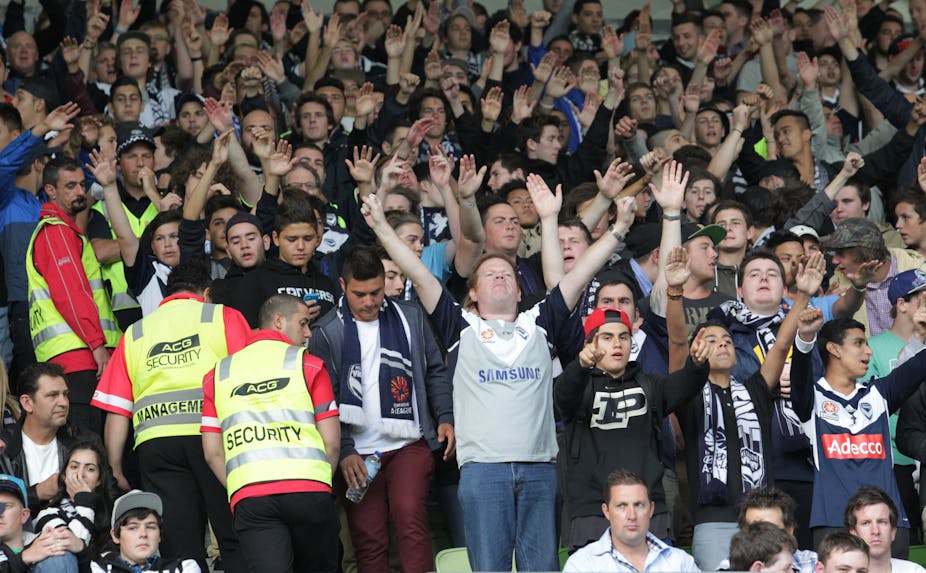The A-League soccer game between Melbourne Victory and Western Sydney Wanderers late last year attracted national media headlines for all the wrong reasons: brawls between opposing fans outside a city pub, flares inside the ground.
For some, including the authorities, these behaviours exemplify the lingering menace of fan violence as well as the possible emergence of a “soccer hooligan” culture in Australia. Both clubs have accepted a three-point deduction, suspended until the end of the 2013-14 season, for their fans’ misbehaviour.
However, media commentary is not a reliable indicator of the severity of fan violence in Australian soccer. In reality, levels of fan violence in Australian soccer are similar to those experienced in other Australian football codes. The overwhelming majority of A-League matches run pretty much incident-free.
It seems that the sport is tarnished in part by its international reputation as a site for hooliganism, particularly in Europe and South America. Comparable traditions of organised hooliganism don’t exist in any Australian spectator sport, including soccer.
Yet recent events also highlight certain issues that pose public safety and security challenges for the authorities. The displacement of incidents to outside the venue, for example on the way to or from the ground or in the city centre, is one such risk. The hazardous discharge of flares in crowded, closed venues is another.

The presence of large groups of boisterous young males can also be a daunting sight for law enforcers, even when these fans have legitimate intentions.
The A-League as a spectator sport now rivals many of the more established Australian sporting codes. As the popularity of the A-League continues to grow and Australian soccer fandom evolves, the promotion of safe yet exciting events becomes a critical task.
So, how can police, security, clubs and governing bodies develop effective public order management strategies without crippling the positive norms and rituals of fan expression, which produce the unique atmosphere at A-League games?
In answering this question, we can draw on elements of good practice that are currently used overseas. Certain control measures, such as the segregation of home and away fans, may be alien to many Australian sports fans, but are perfectly normalised in most European countries. This is especially the case at games where there is a heightened rivalry between opposing fans.
While segregation can have the unintended consequence of enhancing in-group solidarity and out-group antagonism, such antagonism is typically limited to ritualised aggression: that is, chanting and taunting and delivering insults, rather than any physical violence.
International practice and research tells us that mere repression and “stamping hard on it from above” will not solve the problem. Sure, punishment of serious offences is a necessary component of public order management. For example, the risk of being banned from matches for a long time (coupled with the recognition that such a ban will be strictly enforced) can act as a deterrent.
However, a more holistic public order management framework is required. A thorough understanding of fan culture and group dynamics is central to this. So too is the need to overcome the scepticism that often exists among social control agents, such as police and security, towards engaging in dialogue with soccer fans.

Given that the vast majority of fans have legitimate intentions and do not seek to cause or contribute to violence, public order management ought to facilitate rather than control the majority of fans. Police and security also need to be able to respond selectively and differentiate between fans acting inappropriately and those engaging in lawful behaviours, based on information from events as those events develop.
If they treat all fans as potentially dangerous or react to the violent behaviour of some fans by imposing restraint on all, then this increases the likelihood of violating fan conceptions of legitimacy and inviting hostile crowd reactions.
Active communication and dialogue with fans can prevent or de-escalate conflict situations. Many active soccer fans want to play a role in promoting their game.
In some cases, fans, clubs, police and security have developed notions of shared responsibility. Fans are actively engaged in decision-making, contribute to the promotion of pro-social behaviours among their ranks and self-police behaviours that they consider illegitimate and harmful.
This type of approach has been quite effective at clubs such as Spanish La Liga club Espanyol. That club had experienced considerable hooligan problems which were reduced through the collaborative efforts of active fan groups and the club.
Some A-League clubs have sought to engage fans and keep communication channels open. Yet dialogue can easily break down due to misunderstandings or frictions.
Fostering longer-term relationships and co-operation between diverse stakeholders – including fan groups – will be pivotal to the development of the A-League as a premier spectator sport in Australia.

